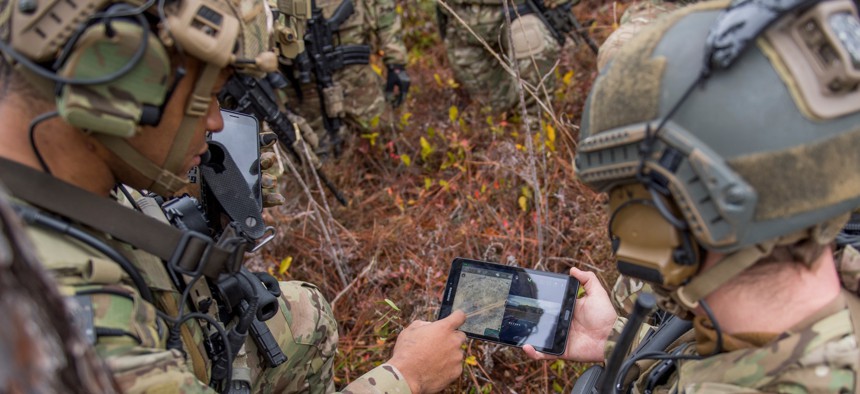
6th Special Operations Squadron during an exercise showcasing the capabilities of the ABMS at Duke Field, Fla., Dec. 17, 2019. U.S. Air Force photo by Tech. Sgt. Joshua J. Garcia
Why We Need the Advanced Battle Management System
The character of war is changing; ABMS provides the tools for effective command and control into the future.
As each service branch looks to the future of joint command and control, we seem to be swimming in a sea of new terms and initiatives: CJADC2, JCC2, Project Convergence, Project Overmatch, and Advanced Battle Management System, or ABMS, to name a few. Consequently, like the parable of the blind man trying to describe the elephant while only touching one part, it can be easy to lose the context of the whole. In the end, as one delves into the unique capabilities, approaches, and attributes of each of the parts, the “elephant” is effective command and control for 21st century warfare
Command and control, or C2, is as old as warfare. It is the art of command and the science of control, combined for the explicit purpose of orchestrating the battle that gives us the greatest advantage over our adversary. From Alexander the Great to our current joint force commanders, the importance of effective C2 is undeniable, and is often the difference between victory and defeat. At its heart, C2 relies upon two main elements: timely, decision-quality information and effective communication. Without the first, the commander can’t effectively assess the situation and formulate appropriate operational approaches and tactics; and without the second, effective execution is certainly at risk. The requirements haven’t changed over time, but the tools to deliver on those requirements have evolved with the changing character of war.
From the Air Force’s perspective, the dawn of airpower ushered in, among many other things, a new perspective and set of tools to enhance C2. The ability to fly over the battlespace extended the range across which commanders could gain situational awareness from tens to hundreds of miles. Operations in this new domain also punctuated the requirement for speed, in both decision-making and action to exploit fleeting opportunities. The U.S. Air Force ethos was forged in this fire. During World War II, newly developed radar technology and an integrated intelligence and communications network helped the British “sense, make sense, and act” at a speed that enabled them to check the German air offensive and deter a ground invasion. This was a turning point early in the conflict.
Through the latter half of the 20th century, C2 became even more complex as combined arms required greater deconfliction and eventually integration. As the range and speed of our capabilities increased, so too did our reliance on an increasingly complex command-and-control system that could operate at a faster pace with a theater-wide perspective. Joint doctrine instantiated this recognition through new constructs such as the airspace control authority and area air defense commander. The Air Force responded with new tools and constructs to address these realities, among them capabilities like Airborne Warning And Control System, or AWACS; Joint Surveillance Target Attack Radar System, or JSTARS; and Air Operations Centers, or AOCs.
The AOCs have evolved to adapt to the need for more rapid and effective joint integration, and provide a solid foundation for joint C2 constructs going forward. Walk into most any AOC and you will see representation from all of the services, as well as our allies and partners. Continuous adaptation and modernization of C2 on behalf of the joint force has always been a core principle as we modernize air and space power.
In the past few decades, the complexity of C2 has increased yet again with joint forces interacting across new cyber and space domains, near-simultaneously. The increased reach of potential adversaries requires a true trans-regional and global perspective to C2. Warfare is becoming much faster, as are the decisions required in competition and crisis. We must once again adapt our tools for effective C2 to confront this reality, and this is the focus of the Air Forces’ Advanced Battle Management System — a way for humans and algorithms to manage mass quantities of data securely from multiple sources through multiple domains that is ingested, fused, processed, and presented in a manner useful to commanders.
But what exactly is ABMS? Is it software? Hardware? Infrastructure? Policy? The answer is yes to all. There is obviously a significant software and digital backbone to enable the integration, fusion, algorithm development, and protection of the massive data we must feed our commanders. There will be hardware requirements to enable our current platforms and systems to send, receive, and process the data required, and enable the theater-wide and global distribution of that data. To do this, we must adapt our infrastructure to enhance the speed, agility, and resilience of the entire ABMS. We also will need policy and process changes, both within and between the services. This will be necessary to support and optimize the performance of the algorithms and ensure that all the data required to every service is available so that they may be able to best feed the joint force commander with decision-quality information and hold an advantage over our adversaries.
The Air Force approach to ABMS is to connect and integrate all U.S. Air Force and U.S. Space Force capabilities while simultaneously ensuring we can connect to other service branches as a joint force. Stove-piped, single-service solutions that don’t integrate for joint force commanders are of little use in future joint warfare. Fast, agile, and resilient joint C2 is a future war-fighting imperative, and ABMS will answer that call.
Gen. David Allvin is the U.S. Air Force vice chief of staff.



